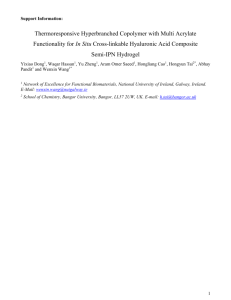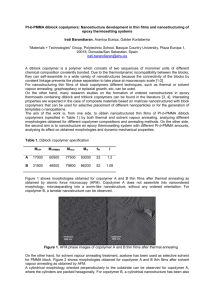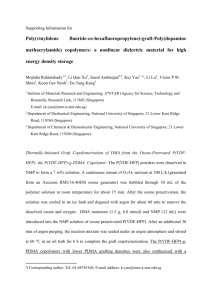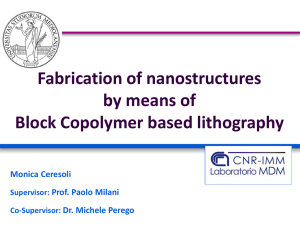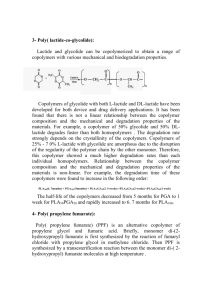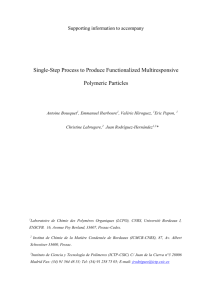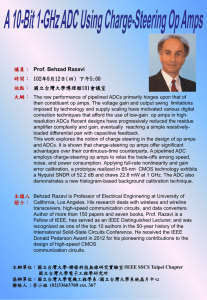Template for Electronic Submission to ACS Journals
advertisement
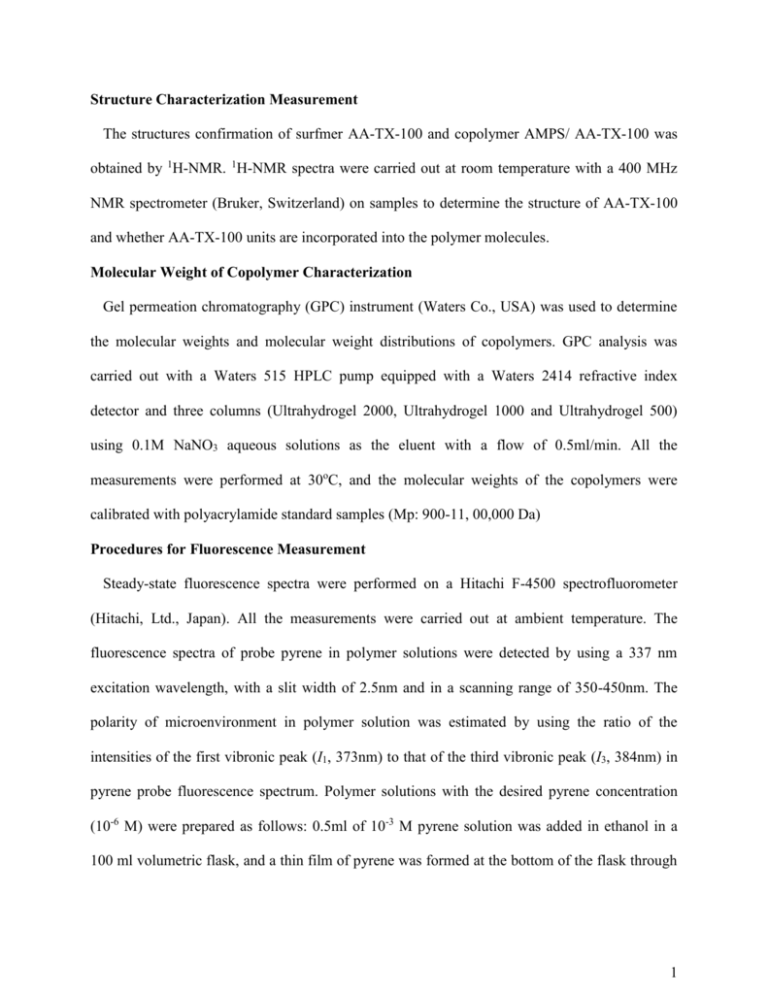
Structure Characterization Measurement The structures confirmation of surfmer AA-TX-100 and copolymer AMPS/ AA-TX-100 was obtained by 1H-NMR. 1H-NMR spectra were carried out at room temperature with a 400 MHz NMR spectrometer (Bruker, Switzerland) on samples to determine the structure of AA-TX-100 and whether AA-TX-100 units are incorporated into the polymer molecules. Molecular Weight of Copolymer Characterization Gel permeation chromatography (GPC) instrument (Waters Co., USA) was used to determine the molecular weights and molecular weight distributions of copolymers. GPC analysis was carried out with a Waters 515 HPLC pump equipped with a Waters 2414 refractive index detector and three columns (Ultrahydrogel 2000, Ultrahydrogel 1000 and Ultrahydrogel 500) using 0.1M NaNO3 aqueous solutions as the eluent with a flow of 0.5ml/min. All the measurements were performed at 30oC, and the molecular weights of the copolymers were calibrated with polyacrylamide standard samples (Mp: 900-11, 00,000 Da) Procedures for Fluorescence Measurement Steady-state fluorescence spectra were performed on a Hitachi F-4500 spectrofluorometer (Hitachi, Ltd., Japan). All the measurements were carried out at ambient temperature. The fluorescence spectra of probe pyrene in polymer solutions were detected by using a 337 nm excitation wavelength, with a slit width of 2.5nm and in a scanning range of 350-450nm. The polarity of microenvironment in polymer solution was estimated by using the ratio of the intensities of the first vibronic peak (I1, 373nm) to that of the third vibronic peak (I3, 384nm) in pyrene probe fluorescence spectrum. Polymer solutions with the desired pyrene concentration (10-6 M) were prepared as follows: 0.5ml of 10-3 M pyrene solution was added in ethanol in a 100 ml volumetric flask, and a thin film of pyrene was formed at the bottom of the flask through 1 bubbling N2 to evaporate the solvent. Then 50ml polymer solutions were added. The solutions were stirred at room temperature for 24h to reach the equilibrium of pyrene in the aqueous phase. Characterization of surfmer AA-TX-100 The 1H-NMR spectra of surfmer AA-TX-100 in CDCl3 are shown in Figure 1: 0.71 (s, 9H, alkyl –(CH3)3), 1.33 (s, 6H, alkyl -(CH3)2),1.69 (s, 2H, alkyl -CH2), 3.64 (m, 36H, -CH2CH2O- ), 4.11 (t, 2H, -O-CH2-CH2-), 4.31 (t, 2H, -CH2-O-CO-), 5.83 (m, H, CH2=CH-), 6.12 (m, H, CH2=CH-), 6.40 (d, H, -CH= CH2), 6.81 (d, 2H, -CH in benzen ), 7.26 (t, 2H, -CH in benzen ). Figure 1s. The 1H-NMR spectrum of surfmer AA-TX-100 Characterization of Copolymer AMPS/ AA-TX-100 The composition of copolymer was further analyzed and the degree of substitution for surfmer AA-TX-100 units in copolymer AMPS/AA-TX-100 was determined according to the following equations. 2 Ha+Hb=2×3y +3×3y =15y=Aa (1) Hc+Hh+Hi+Hj+Hk+Hl=2y+y+2y+ x+2x +2×3x=5y+9x= Ab (2) The equations are solved and got the final equation: y 9A𝑎 Surfmer unit mol% = x = 15A 𝑏 −5A𝑎 × 100% (3) Where Aa is the integral area for the alkyl -CH3 group in surfmer unit, Ab is the integral area for alkyl -CH2, and –CH2-CH2- in polymer main chain and -CH3 group in AMPS unit. The 1HNMR spectra were shown in Figure 2-4. Figure 2s. The 1H-NMR spectrum of AA-1 3 1 HNMR (400 MHz, CDCl3): 0.70 (a,b, alkyl -(CH3)3), 1.16~2.08 (c, h~m, alkyl -CH2, -CH2- CH- in polymer main chain, -CH3 group in AMPS), 3.42(f,g,n, -CH2CH2O-, alkyl -CH2 group in AMPS), 6.96 (e, -CH in benzen ), 7.40 (d, -CH in benzen ). Surfmer unit mol% = 9 ∗ 15 × 100% = 1.025% 15 ∗ 883 − 5 ∗ 15 Figure 3s. The 1H-NMR spectrum of AA-2.5 1 HNMR (400 MHz, CDCl3): 0.70 (a,b, alkyl -(CH3)3), 1.16~2.08 (c, h~m, alkyl -CH2, -CH2- CH- in polymer main chain, -CH3 group in AMPS), 3.39(f,g,n, -CH2CH2O-, alkyl -CH2 group in AMPS), 6.94 (e, -CH in benzen ), 7.39 (d, -CH in benzen ). Surfmer unit mol% = 9 ∗ 15 × 100% = 2.507% 15 ∗ 364 − 5 ∗ 15 4 Figure 4s. The 1H-NMR spectrum of AA-5 1 HNMR (400 MHz, CDCl3): 0.70 (a,b, alkyl -(CH3)3), 1.13~2.08 (c, h~m, alkyl -CH2, -CH2- CH- in polymer main chain, -CH3 group in AMPS), 3.42(f,g,n, -CH2CH2O-, alkyl -CH2 group in AMPS), 6.93 (e, -CH in benzen ), 7.41 (d, -CH in benzen ). Surfmer unit mol% = 9 ∗ 15 × 100% = 4.972% 15 ∗ 186 − 5 ∗ 15 5 Figure 5s. The 1H-NMR spectrum of PAMPS 1 HNMR (400 MHz, CDCl3): 1.54 (a,c,d, -CH2- in polymer main chain, -CH3 group in AMPS), 2.07 (b, -CH- in polymer main chain), 3.38(e, -CH2 group in AMPS) 6 Results of GPC Test Figure 6s. The GPC result of AA-1 7 Figure 7s. The GPC result of AA-2.5 8 9 Figure 8s. The GPC result of AA-5 10 Figure 9s. The GPC result of PAMPS 11 Synthesis Optimization of Copolymer AMPS/AA-TX-100 series In Table 1.1s, the synthesis conditions of copolymer AA-1 were optimized. The effect of initiator on the apparent viscosity of copolymer AA-1 was investigated and shown in entries 1~ 5 showed that the copolymer could achieve the best apparent viscosity (461.6mPa.s) as the amount of initiator was 0.4 mol%. In addition, the reaction temperature and reaction time for copolymer AA-1 were both studied in entries 6~15. The results clearly showed that the apparent viscosity of copolymer solution could reach to 491.1mPa.s as the reaction temperature was 50oC and the reaction time was 4h. TABLE 1.1s. Reaction conditions of copolymer AA-1 Reaction Conditions Entry Apparent Viscosity AA-TXInitiator(mol%)b Temperature(oC) Time(h) 100/AMPS (mPa.s)a,b 1 0.01 0.2 45 24 358.3 2 0.01 0.4 45 24 461.6 3 0.01 0.6 45 24 432.1 4 0.01 0.8 45 24 304 5 0.01 1.2 45 24 277.6 6 0.01 0.4 30 24 358.3 12 7 0.01 0.4 40 24 366.7 8 0.01 0.4 50 24 496.3 9 0.01 0.4 55 24 315.3 10 0.01 0.4 60 24 300.1 11 0.01 0.4 50 12 491.1 12 0.01 0.4 50 8 505.3 13 0.01 0.4 50 6 497.7 14 0.01 0.4 50 4 491.1 15 0.01 0.4 50 2 386.7 In Table 1.2s, the synthesis conditions of copolymer AA-2.5 were optimized. The effect of initiator on the apparent viscosity of copolymer AA-2.5 was investigated and shown in entries 1 ~5 showed that the copolymer could achieve the best apparent viscosity (623.3mPa.s) as the amount of initiator was 0.4 mol%. In addition, the reaction temperature and reaction time for copolymer AA-2.5 were both studied in entries 6~15. The results clearly showed that the apparent viscosity of copolymer solution could reach to 661.3mPa.s as the reaction temperature was 50oC and the reaction time was 6h. Table 1.2s Reaction conditions of copolymer AA-2.5 13 Reaction Conditions Entry Apparent Viscosity AA-TXb Initiator(mol%) o Temperature( C) Time(h) 100/AMPS (mPa.s)a,b 1 0.025 0.2 45 24 551.2 2 0.025 0.4 45 24 623.3 3 0.025 0.6 45 24 603.5 4 0.025 0.8 45 24 579.8 5 0.025 1.2 45 24 541.5 6 0.025 0.4 30 24 537.5 7 0.025 0.4 40 24 607.9 8 0.025 0.4 50 24 621.3 9 0.025 0.4 55 24 567.2 10 0.025 0.4 60 24 472.1 11 0.025 0.4 50 12 672.1 12 0.025 0.4 50 8 667.2 13 0.025 0.4 50 6 661.3 14 0.025 0.4 50 4 556.5 14 15 0.025 0.4 50 2 337.9 In Table 1.3s, the synthesis conditions of copolymer AA-5 were optimized. The effect of initiator on the apparent viscosity of copolymer AA-5 was investigated and shown in entries 1~ 5 showed that the copolymer could achieve the best apparent viscosity (557.1mPa.s) as the amount of initiator was 0.4 mol%. In addition, the reaction temperature and reaction time for copolymer AA-2.5 were both studied in entries 6~15. The results clearly showed that the apparent viscosity of copolymer solution could reach to 661.3mPa.s as the reaction temperature was 50oC and the reaction time was 6h. Table 1.3s Reaction conditions of copolymer AA-5 Reaction Conditions Entry Apparent Viscosity AA-TXInitiator(mol%)b Temperature(oC) Time(h) 100/AMPS (mPa.s)a,b 1 0.05 0.2 45 24 356.3 2 0.05 0.4 45 24 557.1 3 0.05 0.6 45 24 551.3 4 0.05 0.8 45 24 537.8 5 0.05 1.2 45 24 463.1 15 6 0.05 0.4 30 24 377.5 7 0.05 0.4 40 24 507.1 8 0.05 0.4 50 24 571.1 9 0.05 0.4 55 24 423.1 10 0.05 0.4 60 24 411.9 11 0.05 0.4 50 12 567.9 12 0.05 0.4 50 8 583.1 13 0.05 0.4 50 6 571.1 14 0.05 0.4 50 4 375.1 15 0.05 0.4 50 2 207.1 Synthesis of Partially Hydrolyzed Polyacrylamide (HPAM) The copolymer was prepared by the aqueous free-radical copolymerization. AM, AA were dissolved in deionized water in a 250ml flask, and the ratio of AM/AA was 7/3. Then NaHCO3 was used to control the pH value of the reaction solution at 7. The flask was purged with N2 for half an hour. The reactant solution was then heated to 45oC in a tempering kettle under a nitrogen atmosphere. (NH4)2S2O8-NaHSO3 initiator solution (0.3 wt%) was added to the solution and the polymerization proceeded for 6h. The polymer was purified by precipitation with ethanol and dried in vacuum oven at 40oC for 48h. 16 Critical Micelle Concentration of TX-100 and AA-TX-100 The critical micelle concentration (cmc) values of surfactant TX-100 and surfmer AA-TX-100 were determined by surface tension method. The surface tensions were measured by using TX500c spinning drop tensionmeter (Bowing, Stafford, TX) at 30 ± 0.1oC until the surface tensions became constant values. The IFT was calculated and recorded by image acquisition software with an image pick-up device. The cmc value was taken at the intersection of the linear portions of the plots of the surface tension against the logarithm of the surfactant concentration. In Figure 10s, the results show that AA-TX-100 is as good as TX-100 that can form micelles at a very low concentration (at 10-4mol/L). It also indicates that the acrylate group introduced into the structure of surfmer AA-TX-100 has a slight contribution to the cmc value of AA-TX100 since the cmc value of TX-100 is just a little smaller than the one of AA-TX-100. 41 TX-100 40 AA-TX-100 Surface tension (mN/m) 39 38 37 36 cmcTX-100: 2.980 mol/L 35 cmcAA-TX-100: 2.105 mol/L 34 33 32 31 1E-5 1E-4 1E-3 0.01 Concentration (mol/L) Figure 10s. Surface tension vs logC plots for TX-100 and AA-TX-100 17 Effect of NaCl concentration on the aggregation of copolymers The steady-state fluorescence test was carried out to reveal the aggregation behaviors of copolymer AMPS/AA-TX-100 series at different NaCl concentration solutions at molecular level. The variations of intensity ratio I1/I3 as a function of NaCl concentration for copolymer AMPS/ AA-TX-100 series at 2000mg/L are plotted and shown in Figure 11s. In AMPS/AA-TX-100 series, the ratios of I1/I3 are sharply increased with the increment of NaCl concentration at the range of low NaCl concentration, which results from the intermolecular hydrophobic association into intramolecular hydrophobic association that just can form small aggregates and only a few pyrene molecules have opportunity to be distributed into a nonaqueous environment. Finally, the ratio of I1/I3 has slight change at high NaCl concentration, which indicates that the aggregations have already transformed from intermolecular hydrophobic association to intramolecular hydrophobic association. Generally, the intermolecular hydrophobic association will be increased with the increase in the polarity of solution as the addition of salt. 18, 31 However, copolymer AMPS/AA-TX-100 series show different aggregation behaviors. This may be due to the high content of hydrophobic microblock structure introduced into the copolymer chain. On one hand, copolymer with high content of hydrophobic groups that are distributed in microblock manner along the polymer backbone will be much more susceptible to form intramolecular aggregates and have a smaller hydrodynamic volume in brine solution than the copolymer with low content of hydrophobic units that are randomly distributed hydrophobic groups. On the other hand, the hydrophobic interaction of surfmer AA-TX-100 is too strong that also can induce the copolymers with high content hydrophobic groups easily to form intramolecular aggregates in brine solution. 18 1.55 1.50 1.45 I1/I3 1.40 1.35 AA-1 AA-2.5 AA-5 1.30 1.25 Copolymer Concentration: 2000mg/L 1.20 0 2000 4000 6000 8000 10000 NaCl Concentration(mg/L) Figure 11s. Effect of NaCl concentration on the ratio of I1/I3 3.7 Effect of Temperature on Apparent Viscosity The thermal stability of polymer solutions was measured by HAAKE MARS III rotational rheometer. The correlation between apparent viscosity and temperature was obtained by changing the temperature from 30 to 120oC at 7.34s-1 and the cylinder rotor PZ38 was used for the test. Figure 12s shows that copolymer AMPS/AA-TX-100 series have good thermal stability. The apparent viscosities of copolymer AMPS/AA-TX-100 series are gradually reduced with raising temperature. The copolymers show good retention of viscosities at high temperature. As the temperature is 100oC, the viscosity retention rates of copolymer AA-1, AA-2.5, AA-5 are about 31.3%, 69.3%, 64.1%. These results indicate that the temperature plays a major role in controlling the viscosity of copolymer solution. As the hydrophobic association is endothermic, raising temperature will increase the motion of polymer molecules that transform hydrophobic 19 intramolecualr association into intermolecular association at low temperature, which can form large hydrophobic microdomains to build up a high viscosity. However, the increasing motion of polymer molecules also can lead to the reduction in connectivity of the network at high temperature, resulting in breakage of network structure. Once the effect of connectivity loss in the network surpasses the effect of hydrophobic microdomains, the apparent viscosity of polymer solution begins to gradually reduce. Besides, anion group –SO32- in the polymer chain makes contribute to enhance temperature resistance of copolymers as anion groups –SO32- is very stable in high temperature. The combined interaction of these effects helps copolymer AMPS/AA-TX100 series achieve good thermal stability at high temperature. 1000 150 100 100 75 50 AA-1 AA-2.5 T in oC AA-5 Polymer concentration: 5000mg/L Temperature (oC) Apparent viscosity (mPa.s) 125 25 10 0 0 500 1000 1500 2000 2500 Time (s-1) FIGURE 12s. Effect of temperature on the viscosity of copolymer solution 20
